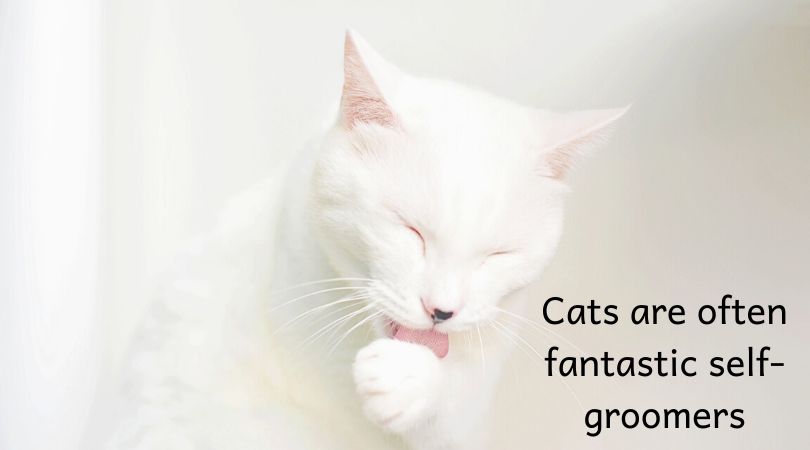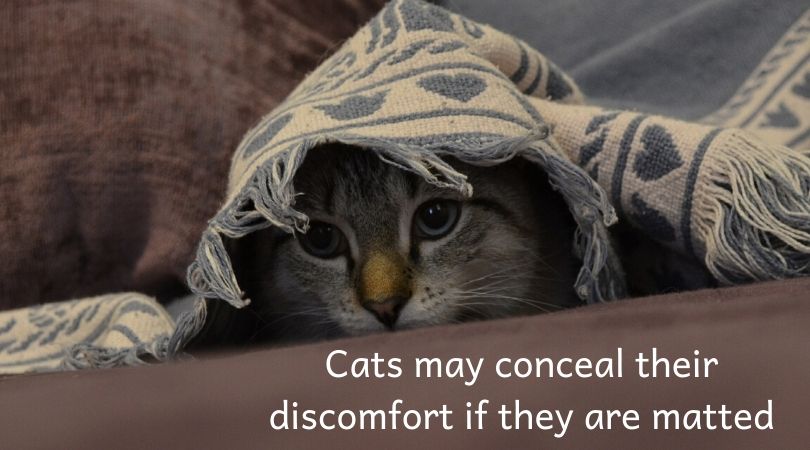Matted fur is a condition that occurs mostly in longhaired cats when their fur becomes knotted and entangled. There are several reasons this can happen. When a cat sheds their undercoat, the fur can become caught in the top coat. If a cat’s fur becomes dirty or oily, it can also become entwined and matted. Matting can also occur in places on the cat’s body that involves a lot of movement such as between the legs, under the chest, and around the collar. The longer matted fur is left unattended, the more problematic it becomes, as the knots will grow tighter and cause discomfort and possibly health issues for your cat.
How do Cats Self-Groom?
Cats are fantastic self-groomers, spending much of their day on personal grooming. Their tongues have tiny backward-facing barbs called papillae, which are great for removing dirt and loose hair. These barbs also promote circulation to the skin. A cat’s flexibility is another asset to their ability to groom themselves.

When Self-Grooming isn’t Enough, How Can You Prevent Matting?
Despite cats’ great ability to groom themselves, matting can and does still occur, especially with longhaired cats. For one, there are a lot of hairs to attend to on a cat’s body, and even the most dutiful groomers may not be able to catch everything. The areas where a lot of rubbing and movement take place can also prove difficult.
Health issues are another factor that may impede your cat’s ability to self-groom. Older cats, arthritic cats, and overweight cats may not have the flexibility to properly groom themselves to prevent matting. Additionally, since the primary grooming tool is their mouth, any cats with oral injury or disease may resist grooming themselves.
Regular Brushing
The best way to help prevent your cat’s fur from becoming matted is to comb them every day, especially if they are a longhaired cat. It’s important to establish a routine for grooming so your cat becomes accustomed to the process and does not get stressed by it. Most cats will enjoy being groomed, but it’s a good idea to start slowly so they don’t get scared by the brush or feel that they’re in an uncomfortable situation. You can start with a soft bristle brush at first just to get them used to being brushed.
Once your cat will sit calmly and allow you to brush them, you can switch to a comb or brush that is appropriate for your cat’s fur. If they are a longhaired cat you want to make sure you’re using a comb or brush designed for that fur type. You’ll want to brush down to the under coat to remove the shedding fur that can get tangled in the top coat.
Be thorough and brush all of your cat’s body. Daily brushes are much more effective than a big brush after several days have passed.
Professional Grooming
You may want to consider getting some professional grooming help if your cat has difficult fur that is more prone to matting, or if they dislike and resist brushing at home. The grooming staff will also be able to provide you grooming tips.
Diet and Nutrition
Diet plays a significant role in the health of your cat’s coat. If your cat’s fur seems to be problematic, talk to your veterinarian about changing her diet to one that, for example, includes more vitamin E and Omega 3 fatty acids, which are very beneficial to a healthy coat.
What to Do if Your Cat Becomes Matted
If your cat’s fur becomes matted, you can try to brush or comb it out using your fingers or a mat breaker. Mat breakers are smaller than typical grooming brushes and can sometimes detangle mats that are not too tight. However, you do not want to cause your cat any pain or the stress of a prolonged brushing session. Never use scissors to try to cut mats out.
For serious cases of matting, you should seek help from a professional groomer or your veterinarian.
If the mats are only affecting your cat’s fur, a professional groomer can remove them either by combing or by shaving them off with electric clippers. If the mats are affecting the skin as well, veterinary care may be needed to remove them and care for any inflammation and irritation of the skin.

Dangers of Matting
If not kept under control, what can start as a minor nuisance can eventually lead to great discomfort and then health issues for your cat. Cats are notorious for concealing their pain and discomfort. They don’t talk to us or tell us when they are in pain, so it’s up to the owner to be aware of their behavior and notice any changes in it. Over time, mats grow tighter, and become itchy, and become hot on the cat’s skin, causing great discomfort. Eventually the skin becomes irritated and inflamed, risking possible infection. Extreme cases of matting may require the cat being put under anesthesia and shaved.
If you notice that your once fastidious groomer cat is being a little lackluster in their grooming habits, it may be time for a visit with your veterinarian to make sure there are no underlying health issues preventing them from self-grooming properly. Or if you have any concerns or questions about matting and your cat, don’t hesitate to contact your veterinarian.
The Drake Center for Veterinary Care is an AAHA-accredited animal hospital located in Encinitas, CA. The Drake Center loves being a source of information for all pet owners across the country however if you have any questions regarding pet care and do not live in Encinitas, CA or surrounding cities, we encourage you to contact your local veterinarian.

